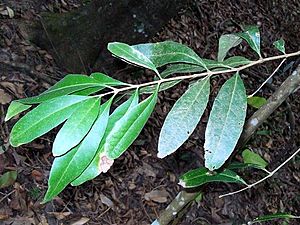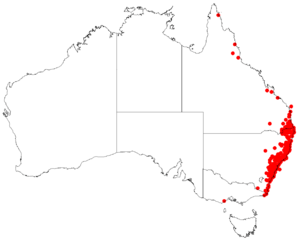Large mock-olive facts for kids
Quick facts for kids Large mock-olive |
|
|---|---|
 |
|
| Large mock-olive on a sand dune behind Seven Mile Beach, New South Wales, Australia | |
 |
|
| Flowers: Bangalley Head, Avalon, New South Wales | |
| Scientific classification | |
| Genus: |
Notelaea
|
| Species: |
longifolia
|
 |
|
| Collections data from AVH | |
| Synonyms | |
|
|
The Notelaea longifolia is a very common plant. It can be a shrub or a small tree. You can find it in eastern Australia. It grows in or near rainforests. Its range stretches from Mimosa Rocks National Park in the south to Bamaga in far north Queensland. People often call it the large mock-olive or long-leaved-olive. It is also a nice plant to grow in gardens.
Contents
What Does the Large Mock-Olive Look Like?
This plant is usually a shrub about 3 metres (10 feet) tall. But sometimes, it can grow much taller. It can reach up to 9 metres (30 feet) high. Its trunk can be as wide as 30 centimetres (12 inches). The trunk is often bent or crooked. The top part of the tree, called the crown, is wide and thick.
The bark is grey-brown. It feels scaly, has cracks, and is hard. The small branches have tiny pale spots called lenticels. These spots help the plant breathe. The branches themselves are pale brown and thin.
Leaves of the Mock-Olive
The leaves of the large mock-olive come in different sizes and shapes. Some leaves are narrow and pointed. Others are wider and shaped like a spear. Some can even be broad and egg-shaped. They are usually between 3 and 16 centimetres (1 to 6 inches) long. They can be 1 to 6 centimetres (0.4 to 2.4 inches) wide.
Sometimes the leaves have a clear tip. Other times, they are more rounded at the end. The leaves get narrower as they reach the stem. They are dark green on top and a duller green underneath. They feel stiff and dry when you touch them. The leaf stalks are either very short or missing. You can see the veins on the leaves. However, the network of veins is not as clear as in a similar plant, the Notelaea venosa.
Flowers and Fruit: Life Cycle
Pale yellow flowers usually grow on this plant. They appear between April and October. These flowers grow in clusters called racemes. These racemes are about 2 centimetres (0.8 inches) long. They grow where the leaves meet the stem, which is called the leaf axil.
The fruit of the large mock-olive ripens from November to March. It is a dark blue or black fruit. It is soft and fleshy. This type of fruit is called a drupe. It is 10 to 16 millimetres (0.4 to 0.6 inches) long. Inside, there is one seed. The seed can be pointed or egg-shaped. It is 8 to 12 millimetres (0.3 to 0.5 inches) long. If you plant a fresh seed, it grows very slowly. It can take up to a year for the seed to sprout.
See also

- In Spanish: Notelaea longifolia para niños

